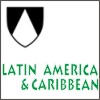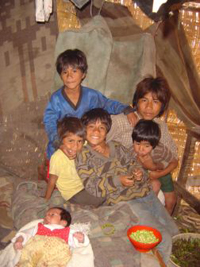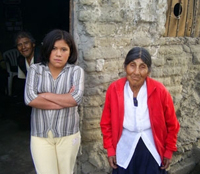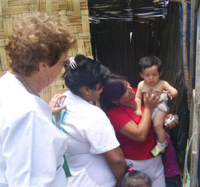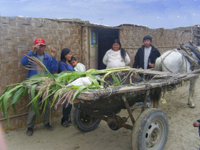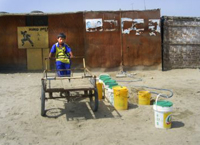|
|
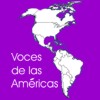
|
||
| Home | Sisters | Associates | Friars | Laity | Nuns | Link to Groups | World OP | DLC | |||
2005
Meeting
Voices of the
Americas
CODALC
website
(Spanish)
CIDALC
website
(Spanish)
Latin American
Press website
United Nations
New York
Geneva
| Voices of the Americas | |||
| Chimbote, Peru Visits To Desert Homes Bring Hope and Care Joyce Ann Hertzig, OP (Grand Rapids) Joyce Ann Hertzig, OP, a member of the Grand Rapids General Council, visited Peru in January/February 2007 and brought back several stories about the people she met and the ministry of Dominicans in the mountains.
The Postamedica, the outpatient service, treats about 150 persons each day. A clinical laboratory and orphanage bring healing and hope as well. The Center has raised the level of health-care in the fishing town of Chimbote and presently has 96 persons on the payroll. The current unemployment (or underemployment rate) in Chimbote is estimated at 70% for a population of 350,000. Floods, earthquakes, violence and shifts in the el Niño current which caused a change in the fish supply contribute to the immense poverty. Any health care professional will tell you that poverty promotes malnutrition, illness, and disease. There are a number of slum sections in the city with sandy roads. Woven straw mats serve as walls for the houses, buckets hold the water supply and stone fire stoves are used for cooking.. A few homes are made of dried adobe. Others have metal sheets for walls. The large majority are made of woven straw mats held upright by long narrow cane poles. I was amazed that an ocean breeze or a faulty pole didn’t collapse an entire village. This did not happen while I was there, but I was reminded of the fairy tale of the three pigs, who built their houses with straw, sticks and bricks We travel the roads and visit the people in these straw, stick and brick houses. Sisters Margaret Mary Birchmeier and Lillian Bockheim believe that their continued home visits encourage people to come to the Maternity Center for visits and follow-up care. This allows the sisters to extend hope and healing Each morning at least two workers go out to visit in the slum areas. I accompanied Elizabeth, the “Outreach Child Malnutrition Coordinator”, and Sister Lillian. We first visited an “at-risk” baby in La Caletta Hospital. One year old, Jesus was brought to the Center on the previous Thursday. As a severe hydrocephalic child who was very malnourished, Jesus was alive but there seemed to be little hope for his recovery. The hospital needed to do some lab tests and they did not have the equipment. His mother could not afford to take the baby on the six hour trip to Lima for the tests. So Elizabeth called the Maternity Center to have Manuela send someone to the hospital to take the tests. The hospital staff agreed. Meantime, Sister Lillian prayed with a group of three mothers in the unit and asked Jesus’ mother if she wanted Baptism for her child. Another mother was prompting, “Oh yes!” Lillian asked me, “Did you bring any water with you?” I had a water bottle in my bag which now became Baptismal water for baby Jesus. Next, we went to an outlying area where four-year-old, Talia, answered the door and went to fetch an uncle and grandmother. La Abuela (the grandmother) tightly held Rosaria, the baby and hesitated when Elizabeth motioned to hold her. But soon the grandmother brought in a tub with a small amount of water. Elizabeth gave Rosaria a bath. We learned later that the mother, who was suffering from depression, was sleeping and on the previous day had wanted to kill the baby. Luckily, the Center follows-up on a baby until 5 years of age and a mother for one year after giving birth. Reminders for baby wellness and postnatal care are given. Next three children playing in the street recognize the workers and lead us to their home where we meet dad who had a brain tumor. Later we visited a house where a baby has had diarrhea for five days. Elizabeth tells the mother, “It is not good to have the animals in the house. Try to keep the dog outside.” We leave and are greeted by a neighbor who wants us to look at her 3 year-old daughter who has the final stages of chickenpox. After a short conversation, the mother agrees to bring the child to the Center that afternoon. A 13-year-old boy, Roberto, had difficulty walking because of the pain in his legs. We visit and talk while we hear the rooster crowing in the background. The mother is to bring him to the Center the next day. Near the edge of the city dump, we find cobbler Jose and his family. He had TB and recovered because of the help provided by the posta-medica at the Center. He needs the same treatment for his son, Martin. After a ride in the moto-taxi we make another stop to find a young 15-year-old mother with her baby. Baby Isabella, one-year old, had a cleft palate operation but soon afterward an infection caused the incision to break, now continued care is needed. I observed her sister washing clothes in a small tub using a scrub brush and wringing them out. The water would not be wasted; tennis shoes were immersed next.
Again on our return we noticed a new settlement. Elizabeth said that it was not here two weeks ago. Sr. Lillian explained that mountain families come to the city, a desert area, to lay claim to land. They gather the materials to put up their tents, shacks, houses. Overnight the “invasion” happens; a new slum section, El Milagro comes into being. In our home visits, I could see the hope brought to the people. An encouraging word, a smile, joy, the love of Christ was a blessing for each of the people we met. Prayers for each person came easily on our journey. Walking in the desert sun, the feeling of the sandy ground and the needs of the people spoke to my heart. I sensed the Dominican presence in the Sisters and the others who have joined with them. Every day daily bring hope, compassion and care. It is what Dominic would do. |
 Home | Contact Us | DLC Dominican Life | USA is sponsored by the Dominican Leadership Conference, the networking organization for elected leaders in the USA. Dominican Life | USA © 2002-2007, All Rights Reserved Web Editor: Anne Lythgoe, OP |
|---|
